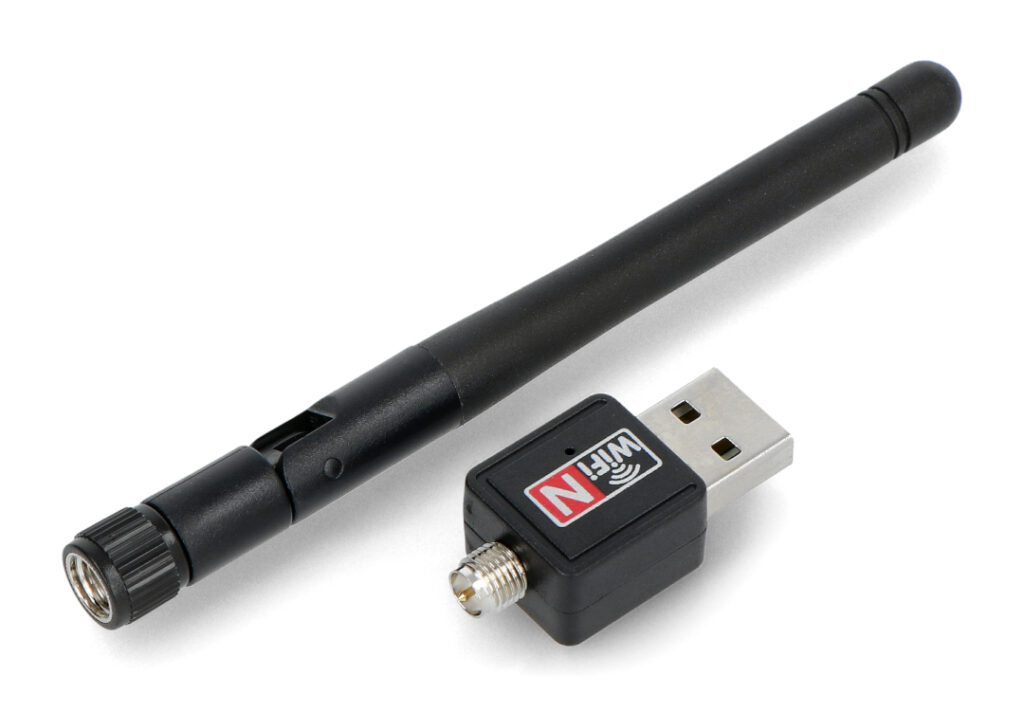Table of Contents:
USB WiFi antennas allow you to connect your computer or other device to a WiFi network via a USB interface. In addition, they are used to increase the range of the WiFi receiver.
USB Wi Fi antenna - the most important information
USB WiFi antennas are devices that allow you to connect a computer or other equipment to a wireless network using a USB communication interface. The way these types of antennas work is based on receiving and sending radio signals in the wireless network standard (e.g.802.11b/g/n/ac).
Selected devices operate on a plug-and-play basis. This means that when connected to a USB port, the device is automatically detected. The next step automatically installs the drivers, after which the equipment is ready to connect to a WiFi network.
USB WiFi antenna design
The USB WiFi antenna is made up of several components. One of them is the radio module, the component responsible for wireless communication. Another is the antenna itself, which comes either integrated into the device or as an external component, such as one with adjustable direction.
The USB WiFi antenna is also equipped with a chipset (such as Realtek), which is responsible for managing the processed digital signals. Another component is a USB connector that allows you to connect the antenna, such as to a computer or other device. Selected antenna models are additionally equipped with a WPS button.
Parameters and compatibility of USB WiFi antennas
USB WiFi antennas are compatible with various operating systems, such as selected versions of Windows, as well as Linux (including Raspberry Pi OS) and macOS. One of the key parameters of USB WiFi antennas is the speed of data transmission. This value informs about the maximum possible data transfer speed between the devices and the connected router. High data transfer speeds are especially important for demanding applications (e.g., for streaming, online gaming and when sending large files).
Other parameters
The next important parameter of antennas is the frequency range. Standard models and older antennas operate only at 2.4 GHz. Modern devices, on the other hand, can operate at both 2.4 GHz and 5 GHz. The most important differences between these frequencies are as follows. 5 GHz can provide higher speeds, but has less range. On the other hand, 2.4 GHz has a longer range and penetrates obstacles better, while offering lower data rates. WiFi standards are another important parameter. The antenna can support standards such as 802.11b, 802.11g, 802.11n, 802.11ac and 802.11ax (WiFi 6).
Application of WiFi USB antennas
USB WiFi antennas are used in increasing the range of a wireless network. They are perfect for places where coverage is poor. Such devices are used to connect desktop computers to a wireless network. Modern antennas offer higher speeds and better stability than the built-in WiFi antennas in some laptops. In addition, they are ideal for travelers who frequently use different WiFi networks and need a reliable connection.
Another application is remote working. This is a good solution for those who connect to the corporate network. Selected antenna models can be used to create hotspots, or access points for other users.
Advantages of USB WiFi antennas
The most important advantages of USB-connected WiFi antennas are their small size and light weight. Another advantage is compatibility with all the most popular operating systems. In addition, the antennas are easy and intuitive to use and usually do not require the installation of external drivers, such as from a disc (as a rule, the installation is automatic).
Some WiFi antennas are composed of two components. The first is the module itself with a USB plug, while the second is the antenna. The connection of these components requires only the twisting of threads. Such models are chosen by users who are looking for compact solutions.
Encryption protocols in USB WiFi antennas
The various USB WiFi antennas differ in the supported encryption protocols, among other things. These are methods of securing data transmission between a computer or other device and a wireless network.
- One of them is WEP (Wired Equivalent Privacy). It is one of the oldest encryption protocols. It uses keys of 64 or 128 bits in length. Nowadays, it is rarely used due to its low level of protection and vulnerability to breaches.
- Another protocol is WPA (for WiFi Protected Access), which was temporarily introduced after the low protection level of the WEP protocol was identified. WPA uses TKIP (Temporal Key Integrity Protocol), a more secure protocol than WEP.
- The USB WiFi antenna can also support WPA-PSK (Wi-Fi Protected Access Pre-Shared Key). This is a version of the WPA protocol in which the encryption key is shared before communication with the wireless network is established. This protocol is used, among others. In home and small business networks.
- The next protocol is WPA2 (for Wi-Fi Protected Access 2). This is an enhanced version of the WPA protocol that uses AES (from the Advanced Encryption Standard) for encryption. This is a more secure and advanced protocol compared to TKIP.
- Selected WiFi antennas also support WPA2-PSK (Wi-Fi Protected Access 2 Pre-Shared Key). This is a version of WPA2 that uses a shared key. This encryption protocol is used, among others. In home wireless networks.
- Modern USB WiFi antennas are also compatible with TKIP/AES protocols. These are two encryption algorithms. TKIP is used in WPA, while AES is used in WPA2. AES is now the standard in modern wireless networks.
The differences between the various encryption protocols include not only the level of security, but also the method of encryption.
How useful was this post?
Click on a star to rate it!
Average rating 5 / 5. Vote count: 5
No votes so far! Be the first to rate this post.




















